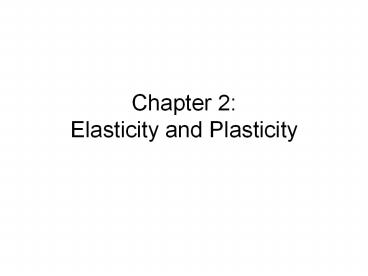Chapter 2: Elasticity and Plasticity - PowerPoint PPT Presentation
Title:
Chapter 2: Elasticity and Plasticity
Description:
Stress strain curves in an elastic regime. ( a) Typical curve for ... Anisotropy of Cubic System. Zener's anisotropy ratio. Young's modulus. Shear modulus ... – PowerPoint PPT presentation
Number of Views:2761
Avg rating:3.0/5.0
Title: Chapter 2: Elasticity and Plasticity
1
Chapter 2Elasticity and Plasticity
2
Tensile Strength Testing Machine
3
Elasticity
Stressstrain curves in an elastic regime. (a)
Typical curve for metals and ceramics. (b)
Typical curve for rubber.
4
Strain Energy Density
5
Shear Stress and Strain
(a) Specimen subjected to shear force. (b) Strain
undergone by small cube in shearregion. (c)
Specimen (cylinder)subjected to torsion by a
torque T.
6
Poissons Ratio
In an isotropic material, e11 is equal to e22.
(a) Unit cube being extended in direction Ox3.
(b) Unit cube in body subjected to tridimensional
stress only stresses on the three exposed faces
of the cube are shown.
7
More Complex State of Stresses
8
Mohr Circle
(a) Biaxial (or bidimensional) state of stress.
(b) Mohr circle and construction of general
orientation 0X1 X2 (c) Mohr circle and
construction of principal stresses and
maximum shear stresses (Method I).
9
Mohr Circle
10
Pure Shear
11
Anisotropic Effects
12
Elastic Modulus
13
Elastic Compliance and Stiffness Matrix
14
Anisotropy of Cubic System
Zeners anisotropy ratio
Youngs modulus
Shear modulus
Bulk modulus
Poissons ratio
Lame constants
15
Youngs Modulus and Shear Modulus of
Monocrystalline Cu
16
Youngs Modulus and Shear Modulus Monocrystalline
Zirconia
17
Tridimensional Polar Plot for Zirconium
18
Polycrystal
Voigt average assume strain is same everywhere
Reuss average assume stress is same everywhere
19
Porosity on Youngs Modulus
Watchman and Mackenzie
20
Microcracks vs. Youngs Modulus
21
Microcracks vs. Youngs Modulus (contd)
1973 Salganik model
1974 Oconnel Budiansky model
22
Elastic Properties of Polymers
23
Viscoelasticity
n0 plastic n1 linear viscous (Newtonian) n
power law
Viscosity coefficient
Fluidity
24
Viscoelasticity (contd)
Tensile storage modulus
Tensile loss modulus
25
Rubber Elasticity
From thermodynamics, one can derive
Extension ratio
26
Elastic Properties of Biological Materials
(a) Stressstrain response of human vena cava
circles-loading squares-unloading. (Adapted from
Y. C. Fung, Biomechanics (New York Springer,
1993),p. 366.) (b) Representation of mechanical
response in terms of tangent modulus (slope of
stressstrain curve) vs. stress. (Adapted from Y.
C. Fung. Biomechanics, New York Springer,1993),
p. 329.)
27
Blood Vessels Dimensions
28
Residual Stresses in Arteries
29
Cartilage Fiber Network
30
Mesostructure of Cartilage
(a) Mesostructure of cartilage (consisting of
four zones) showing differences in structure as a
function of distance from surface the bone
attachment is at bottom. (From G. L. Lucas, F. W.
Cooke, and E. A. Friis, A Primer on Biomechanics
(New York Springer, 1999), p. 273.) (b)
Cross-section of human cartilage showing regions
drawn schematically in (a). (Courtesy of K. D.
Jadin and R. I. Shah.)
31
Mechanical Behavior of Superficial Zone of
Cartilage
Stressstrain curve for samples from the
superficial zone of articular cartilage. Samples
were cut parallel and perpendicular to collagen
fiber orientation. (From G. E. Kempson,
Mechanical Properties of Articular Cartilage. In
Adult Articular Cartilage, ed. M. A. R. Freeman
(London Sir Isaac Pitman and Sons Ltd., 1973),
pp. 171228.)
32
Mechanical Properties of a DNA
33
Stretching Force vs. Relative Extension for a DNA
Molecule
34
Stresses Acting on a Thin Film
Effect of stresses acting on thin film on bending
of substrate (a) tensile stresses in thin film
(b) compressive stresses in thin film.
35
Elastic Constant and Bonding
Two atoms with an imaginary spring between them
(a) equilibrium position (b) stretched
configuration under tensile force (c) compressed
configuration under compressive force.
36
Attraction and Repulsion Between Two Atoms
(a) Interaction energies (attractive and
repulsive terms) as a function of separation (b)
Force between two atoms as a function of
separation notice decrease in slope as
separation increases.































